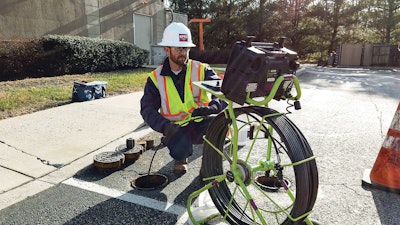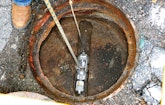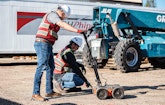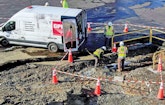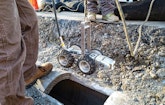Interested in Inspection?
Get Inspection articles, news and videos right in your inbox! Sign up now.
Inspection + Get AlertsGround Penetrating Radar Systems started like most construction service companies: relatively small, based out of a single region, providing services just to customers within reach, and with high hopes of growing over time.
They certainly turned those hopes into a reality over the past two decades, burgeoning into a nationwide company with offices in every major market across the U.S. Along with an expanded footprint has come added services, something GPRS says has been done strategically, which has contributed to its overall success.
As the name suggests, GPRS started in 2001 as a concrete scanning company using ground-penetrating radar, focused primarily in Toledo, Ohio, and Detroit. Matt Aston, president and CEO of GPRS, started the company after his father — the owner of a concrete core drilling company — showed him a magazine article introducing the idea of a new tool at the time, GPR.
“Matt decided to buy a system with the intent of helping his father’s company avoid cutting and coring through dangerous conduits and cables underground,” says Jason Schaff, GPRS’s vice president of sales and marketing. “Matt never had any intention of taking his services beyond that, but he saw the demand from all over the region and ultimately the country. The phone rang off the hook, so he decided to start growing his company.”
Roughly five years after its inception, GPRS added utility locating services to meet the demand it was seeing from customers. Noticing an opening in the market and a need for these services nationwide, Aston decided to take a leap of faith and start expanding across the U.S.
“This was a make-it-or-break-it turning point for GPRS,” Schaff says of Aston’s decision.
It began to grow by opening offices in Dallas; Los Angeles; Denver; Washington, D.C.; Charlotte, North Carolina; Orlando, Florida; and Chicago. Today GPRS has 410 employees. The company completed 70,000 individual projects from coast to coast in 2019, with an accuracy rate above 99%.
Strategic growth
The vertical growth of GPRS has happened both organically and systematically, as the business acquired several smaller companies over the years to reach into existing markets and offer additional services.
Early in 2018, GPRS acquired Encompass Inspections, based out of Phoenix; Structural Radar Imaging of Seattle; and National GPR Service in Minneapolis. A year later, it acquired Master Locators, based in Pennsylvania. These acquisitions led GPRS into the world of pipe inspection services, allowing crews to do more for its customers, Schaff says.
With each new service the company has added during the past 20 years, the company takes the same strategic approach with implementing it, he says. GPRS first conservatively purchases equipment and hires and trains crews in the cities it sees the greatest demand. From there, it expands into new markets where it finds enough requests for the service.
Over the past year, growing its pipeline inspection services has been a major focus for GPRS as it works toward adding those capabilities and equipment to each branch already offering locating. But this time around, GPRS didn’t need to search the market for the right equipment to get the new service up and running.
Before the acquisition, Master Locators had been relying on Envirosight equipment for years, with three ROVVER X mainline crawlers and one ROVVER X SAT lateral launch system in its fleet. It was equipment the company could already trust, and the crew at GPRS was quickly pleased with its performance level and capabilities. Since then, GPRS has purchased more trucks equipped with the ROVVER X inspection crawler for its locations in cities including New York City, Philadelphia, Boston, Atlanta, Chicago, Houston, Toledo and Indianapolis, as well as in Southern California.
“We are strategically placing them across the U.S., and then as the jobs come in, staff at whichever city is closest to travel with the equipment to the job,” says Richard Byrne, pipeline inspection area manager for the Eastern U.S. “Once we see enough requests coming in from a certain area, then we consider adding another vehicle in that location. So we either move a truck or purchase a truck.”
“We will make whichever decision will best service our client,” Schaff says.
Broadening capabilities
Byrne says the inspection equipment has proven to be a great fit for the company’s needs.
“I find Envirosight’s equipment to be much better for what we do,” he says. “Equipment I’ve used previously didn’t give us the option to take it out of the truck and be portable with it. It’s user-friendly and portable to take out and locate and inspect sewer lines that may be running through wooded areas or in areas where you don’t have access to pull a vehicle up to.”
Kyle Humphreys, pipeline inspection manager for the Western U.S., says using Envirosight’s equipment for inspection services has allowed the crew to deliver at the high level they like to achieve.
“I like it for the functionality and ease of use,” Humphreys says. “The overall quality of the system is great, not only the video, but also the equipment itself. Along with that is the deliverable we are able to provide our customer with. I think all of those combined made the choice to stick with Envirosight an easy one.”
Exceeding expectations
Both managers say the portability of the equipment has allowed GPRS to take on diverse jobs its competitors can’t.
“Our goal is to go above and beyond to meet customer needs,” Humphreys says. “For example, I’m out on a job right now in the middle of the woods in Texas that our competitors couldn’t do because they’ve got big trucks and can’t get their equipment out there. We rented a Jeep, put our equipment in the back and are trekking through mud to get to these manholes. Currently we are inspecting about 17,000 linear feet for this part of the project. We did about 10,000 prior to this for the same customer, and we got called back because no one else can do this. We did it in a timely manner, and the customer was pleased with the deliverable.”
Similarly, Byrne and his crew were called to a job to inspect the sanitary lines on Fire Island in New York.
“We put our inspection equipment on a golf cart with a generator and took the ferry across to the island to inspect the island’s lines, which — needless to say — were not in good shape being underwater,” he says.
Without the portable equipment, GPRS wouldn’t be able to complete the number of jobs they do and take on the more unique ones competitors are challenged with.
Along with portability, the regional support and service from Envirosight has been crucial to a company that provides service all over the country, Schaff says. The crews rely on Envirosight’s sales partners, including Haaker Equipment, Green Equipment and A&H Equipment to provide support and service to maximize uptime.
GPRS depends on a suite of tools for concrete scanning and utility locating, Schaff says. The company uses Geophysical Survey Systems Inc. (GSSI) and Proceq GPR scanners; Vivax-Metrotech and Radiodetection electromagnetic locating devices; Schonstedt Instrument magnetometers; and Jameson traceable rodders.
To ensure compliance and consistency, the company follows the Subsurface Investigation Methodology for utility locating, Schaff says.
“SIM is broken into three categories, and it stipulates the different tools we need to use, the amount of training needed, and the methodology by which we do the scanning so that our results are repeatable,” he says. “So while GPR makes up a large portion of what we do, we would say we follow SIM specification more than anything. We are able to see that 99% accuracy rating because of SIM.”
Standing out
Beyond its far-reaching net, there are several factors that GPRS believes make it unique in the industry and have contributed to its success, including using an ownership model with its staff.
“We call our technicians project managers,” Schaff says. “Each project manager is responsible for sales, proposals, completing the job and delivering the report. We call them project managers because we find value for our clients when the technician is able to take a consultative approach. They’re able to answer the call, qualify questions, write a proposal and take them through the actual project with a site walk. We feel like we’re giving something that the industry doesn’t offer: a complete package with the service while communicating with one person. Each project manager is running their own little business for that market.”
Another factor that helps GPRS stand out from its competitors is its deliverable using WinCan software, Humphreys says.
“I’ve seen some from other companies, and our reports are top-notch,” he says. “Customers love the deliverable that we hand them and the customer service they receive. We prioritize taking care of our customers.”
That commitment level has helped GPRS grow organically, oftentimes finding that word-of-mouth has helped the company generate more new customers across the country. And being able to combine services, like GPR and pipeline inspection, helps the crew provide its customers with more information than its competitors could during a single job.
“We can combine different services to give our customers a detailed deliverable,” Schaff says. “We can map out their whole sewer or pipe system based on the tools we have.”
Reaching farther
Like concrete scanning and utility locating, GPRS plans to continue developing its inspection services by moving into every major market, based on the needs it sees.
“We’ll dictate our growth based on the existing systems we have in place now,” Schaff says. “Where are we traveling to the most? Where are we getting the most phone calls? How can we best service our clients and satisfy demands? But our plan is to more aggressively grow on this vertical path than we did with other services. We aren’t going to wait; we are going to act. Nationally, there’s a big opportunity for someone like us to come in and create a name in this industry.”
